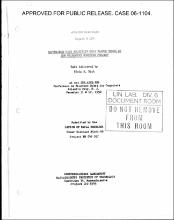Experience with Receiving-Type Vacuum Tubes on the Whirlwind Computer Project
Rich, Edwin S.

DownloadMC665_r11_R-194.pdf (2.192Mb)
Date
1950-12-12Abstract
In high-speed digital computers, particularly those to be used for control of physical systems, vacuum-tube reliability is an important consideration. In such computers, one would like to measure the average time between failures in days or weeks rather than hours. Since there are thousands of components in such machines that can fail and cause operational failures, the average life of these components should be at least several tens of thousands of hours.
Our efforts to obtain improved performance from vacuum tubes indicate that the more significant factors which influence tube life fall into the following classifications: ( l ) tube design construction, and processing; (2) selection of tubes by means of initial tests; (3) design of circuits to provide wide operating margins; and (4) avoidance of operating conditions which are known to be detrimental to tube life. Considerable experience has been obtained on Project Whirlwind with two types of vacuum tubes. They are the 7AD7, a video amplifier pentode, manufactured commercially for radio and television use and the 7AK7, a dual-control-grid pentode specially designed and constructed for computer applications. Our data show that the 7AK7 tubes may be expected to give an average life considerably greater than 20,000 hours and that even the 7AD7 tubes should have an average life of more than 10,000 hours. The results we have obtained may suggest the first steps to be taken to improve tube reliability, but more effort is needed in order to reach the desired goal. Success in a tube improvement program depends on the cooperative effort of both the manufacturers and the users. Each must recognize that reliability is a systems problem, and that a combination of many factors and not just isolated effects determine the ultimate performance that will be obtained.